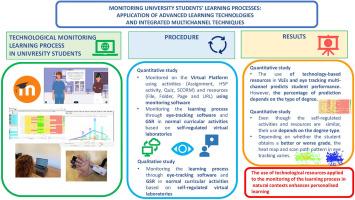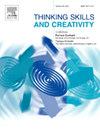Monitoring university students’ learning processes: application of Advanced Learning Technologies and integrated multichannel techniques
IF 4.5
2区 教育学
Q1 Social Sciences
引用次数: 0
Abstract
Using Advanced Learning Technologies (ALT) may facilitate the curriculum space needed to promote students’ thinking skills such as self-regulation of thinking, the use of metacognitive strategies, and monitoring learning behaviours. In addition, using integrated multi-channel eye-tracking, Education Data Mining techniques, and data fusion provides information about how each student deploys these strategies at the process level (rather than the results level) and at a level of detail that other techniques do not. The general objectives of this study were: (1) Determine whether students’ behaviours in the LMS predicted results of their learning in different evaluation tests (individual vs. group); (2) Determine whether behavioural records (physiological and eye-tracking) produced with integrated multi-channel techniques predicted learning results in different evaluation tests (individual vs. group); (3) Test whether student behaviours in resources and activities in ALT environments differed depending on the degree type; and (4) Determine whether the results of monitoring student behaviours in ALT environments via integrated multi-channel technology using heat maps and gaze point differed depending on the students’ learning results. The study was performed during one semester with a sample of 64 university students in their final year of health sciences or biomedical engineering degrees. Their learning behaviour in terms of activities and resources in Moodle was monitored along with their use of self-regulated virtual labs for promoting thinking skills. Learning results were assessed using traditional multiple-choice tests and project-based learning assessments (execution and presentation). The results indicate that the variance in the results explained by the use of activities and resources aimed at acquiring thinking skills was greater in project-based learning assessments in both course groups. In addition, the variance explained by the indicators of cognitive load measured by eye-tracking and Galvanic Skin Response (GSR) was greater for the learning results in traditional testing. The use of ALT resources and self-regulated virtual laboratories enhanced students’ acquisition of thinking skills. Nonetheless, learning activities must be carefully designed and learning behaviours need to be monitored during the learning process in order to tailor the educational response. This requires better teacher—and student—training in using these resources and in interpreting the resulting records.

大学生学习过程监控:先进学习技术与多渠道集成技术的应用
使用高级学习技术(ALT)可以促进提高学生思维技能所需的课程空间,如思维的自我调节、元认知策略的使用和学习行为的监控。此外,使用集成的多渠道眼球追踪、教育数据挖掘技术和数据融合,可以提供关于每个学生如何在过程级别(而不是结果级别)部署这些策略的信息,以及其他技术无法提供的细节级别。本研究的总体目的是:(1)确定学生在LMS中的行为是否能预测其在不同评价测试(个体与群体)中的学习结果;(2)确定综合多通道技术产生的行为记录(生理和眼动追踪)是否能预测不同评估测试(个体与群体)的学习结果;(3)检验学生在ALT环境中的资源和活动行为是否因学位类型的不同而不同;(4)确定基于热图和注视点的多通道综合技术在ALT环境中监测学生行为的结果是否会因学生的学习结果而有所不同。这项研究在一个学期内对64名健康科学或生物医学工程专业最后一年的大学生进行了抽样调查。他们在Moodle的活动和资源方面的学习行为被监控,同时他们使用自我调节的虚拟实验室来提高思维技能。使用传统的选择题测试和基于项目的学习评估(执行和演示)来评估学习结果。结果表明,在两个课程组中,基于项目的学习评估中,旨在获得思维技能的活动和资源的使用解释了结果的差异。此外,眼动追踪和皮肤电反应(GSR)测量的认知负荷指标对传统测试的学习结果解释的方差更大。ALT资源的使用和自我调节的虚拟实验室促进了学生思维技能的习得。尽管如此,必须仔细设计学习活动,并在学习过程中监测学习行为,以便调整教育反应。这就需要对教师和学生进行更好的培训,使他们懂得如何使用这些资源,如何解释产生的记录。
本文章由计算机程序翻译,如有差异,请以英文原文为准。
求助全文
约1分钟内获得全文
求助全文
来源期刊

Thinking Skills and Creativity
EDUCATION & EDUCATIONAL RESEARCH-
CiteScore
6.40
自引率
16.20%
发文量
172
审稿时长
76 days
期刊介绍:
Thinking Skills and Creativity is a new journal providing a peer-reviewed forum for communication and debate for the community of researchers interested in teaching for thinking and creativity. Papers may represent a variety of theoretical perspectives and methodological approaches and may relate to any age level in a diversity of settings: formal and informal, education and work-based.
 求助内容:
求助内容: 应助结果提醒方式:
应助结果提醒方式:


